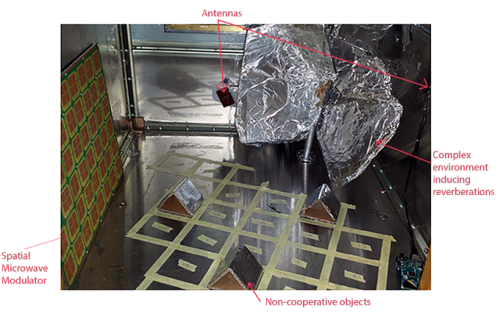Time reversal has revolutionized the localization of objects in a wave field. But only in the case of objects that emit themselves waves, such as cell phones. The situation becomes tricky with “non-cooperative” objects. Indeed, electromagnetic waves reverberating in a typical indoor room are completely scrambled as they are reflected off walls and other objects such that it was so far impossible to localize non-cooperative objects under these conditions. In a work recently published in Physical Review Letters, scientists from Langevin Institute (ESPCI Paris, CNRS), Duke University and the start-up Greenerwave (spin-off of the Langevin Institute) have tackled the challenge of localizing non-cooperative objects in complex environments.

The researchers leverage the fact that a non-cooperative object will inevitably perturb a wave field to which it is exposed. In their recent publication, they manage to extract enough information from the scattered waves to establish a unique fingerprint of the object location. It is the complexity of the environment that ensures the uniqueness of the scattered-wave fingerprint for any location of the object. The researchers thus turn the initial hurdle, namely the environment’s complexity, into a trump card.
The team designed an experimental setup working in the microwave range that enables them to disentangle multiple interwoven fingerprints from several non-cooperative objects. Moreover, by randomly altering how parts of the room’s walls reflect microwaves, they show that the necessary information can be extracted even with a wave field of minimal spectral content. This not only yields a considerable simplification of the experimental setup; it also ensures that the scheme does not interfere with other wireless networks.
Now that the fundamental physics of the problem has been studied, the next steps will seek to get the concept ready for real-life applications. On the one hand, developing a custom-tailored hardware will allow the experimental measurements to be taken in real time. On the other hand, adding a layer of advanced signal processing inspired by artificial neural networks will allow the retrieval of the object locations to be faster and more robust. The system will then be able to follow an object in real time as it moves through a complex environment, and to study scenarios with shape-evolving objects or environments. In the future, the system could be integrated into Smart Homes thanks to its compatibility with wireless networks such as Wi-Fi. It could also replace video-telemonitoring that is deemed to invade people’s privacy. Further applications can be found in gaming or security.
Contact: Philipp del Hougne (philipp.delhougne@gmail.com)
Related publication: Phys. Rev. Lett. 121, 063901 (2018) - Precise Localization of Multiple Noncooperative Objects in a Disordered Cavity by Wave Front Shaping